Seismic
Waves
Introduction
Earth is composed of three main layers.
1.
Crust à the outermost and thinnest layer
2.
Mantle à the middle layer that lies beneath the
crust
3.
Core à the innermost layer and is divided into
a liquid outer core and a solid inner core
How do we know this?
Watch the video at the top of the page, then
answer the questions in your science journal.
1.
What is a seismic wave?
2.
What is one human-made cause
of seismic waves?
3.
What is one natural cause of seismic waves?
4.
How do seismic waves travel?
Scientists use instruments such as the seismograph and geophone to observe how energy travels through the Earth and
determine information about the structure of our planet.
Let’s Practice: Review
Reflection
and Refraction
The scientist who works to understand our
planet's history is called a geologist. A geologist studies
the Earth to predict the future better and explain current occurrences.
Geologists will use geophones which are sensors
that are planted in the ground and convert ground movement into an electrical
signal. The signals from a geophone are fed into sophisticated data processing equipment
and arranged to produce a seismic
reflection record.
Geologists create seismic waves by making an
explosion or dropping a weight onto a vibration plate. As waves pass through
layers of different densities, they change direction. This process is called refraction.
By measuring the refraction and reflection of
the waves, geologists can determine the density, nature, depth, and thickness
of the rock below our surface, helping
them to locate things like fossil fuels, water, and minerals.
In your science
journal, answer these questions.
1.
What skills does a geologist need to be successful in their career?
2.
What are three examples
of fossil fuels?
3.
What four things can a geologist determine by measuring the
refraction and reflection of seismic waves?
Let’s Practice:
Reflection and Refraction
Direct
and Indirect Evidence
Geologists use two main types of evidence to
learn about Earth's interior. They use direct evidence from rock
samples and indirect evidence from seismic waves.
Direct Evidence
Observations you can make yourself are direct
evidence. Scientists observe lava and rocks on Earth's surface. They study
rocks from holes and mines drilled below the surface.
Watch
the edpuzzle original "Patterns of Earth's Features (Volcanoes)."
Indirect Evidence
Indirect evidence is information scientists use
to infer an answer when they can't make observations. It includes a recording
of earthquake waves called seismic waves. Seismic waves produced by
earthquakes allow scientists to measure the speed at which they travel, giving
clues to the planet's structure.
Watch the puzzle original
"Patterns of Earth's Features (Earthquakes)."
In your science
journal, answer these questions.
1.
Would you want to live near a volcano? Why or why not?
2.
What can the Volcano Disaster Assistance Program do to stop future
disasters?
3.
Why do some buildings survive earthquakes?
Seismic
Waves
During an earthquake, seismic waves move
outward throughout our planet. Instruments worldwide record these seismic
waves. The waves include:
·
P waves à which can travel through
solids and liquids
·
S waves à which can travel through
solids but NOT liquids
When seismic waves move from one material into
a different material, their speed and direction change. Either their path bends,
or the new material blocks them.
If Earth were made up of a single layer of the
same material, the seismic waves would pass through Earth. Instead, seismic
waves bend or stop. Using indirect evidence, geologists infer that Earth
consists of different layers of different materials.
Study the image below, then answer these
questions in your science journal.
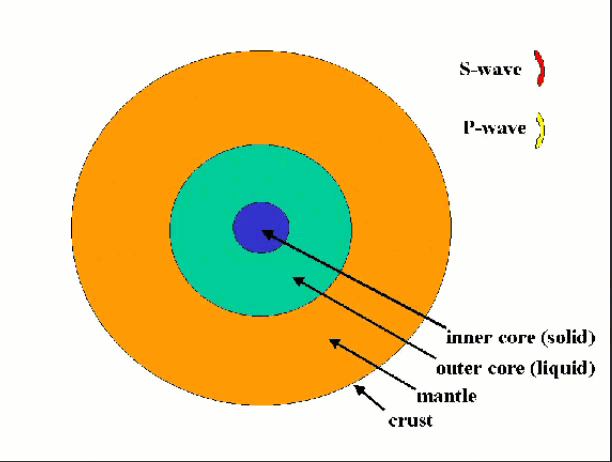
1.
What color are the S-waves?
2.
What color are the P-waves?
3.
Which wave went through the crust, mantle, outer, and inner
core?
Let's Practice: Waves
Earth's
Layers
The Earth's interior consists of three
layers: crust, mantle, and core.
Geologists know more about the crust than the
mantle or core because they can collect direct
evidence.
Crust
The crust is broken into pieces called tectonic plates. Tectonic plates slowly
move on the Earth's surface. The interaction and movement of these plates
create and change landforms. Plate movements create:
·
Mountains
·
Trenches
·
Volcanoes
The crust varies in thickness and is made up of
different rock types. The continental
crust comprises the continents, and the oceanic
crust is under the oceans.
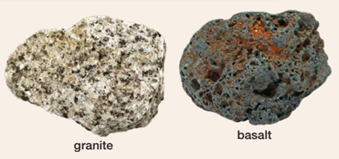
Earth's crust is made up
of granite and basalt.
Mantle
Both P and S waves pass through the crust and
mantle. Geologists infer that this likely means that both layers are solid.
Seismic waves travel faster in the mantle.
Scientists study volcanoes to learn more about
the mantle. During an eruption, mantle rock is forced up to the surface.
Although the mantle is mostly solid, it moves
slowly over time. The tectonic plates in the crust sit on top of the mantle. The
heat within the mantle moves by way of convection
currents. These currents help move the plates and can change landforms on
Earth's surface.
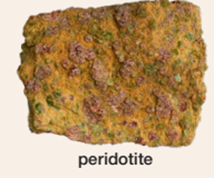
Earth's mantle is mostly
made up of peridotite.
Outer Core
Below the mantle, geologists record a change in
seismic waves at a depth of about 3,000 kilometers. The P waves change speed and direction, and the S waves stop. Since S waves can't pass through liquids,
geologists can infer that a liquid layer exists deep inside the Earth. This
layer is the outer core and is mostly made up of melted iron and nickel.
Convection currents move material around
the outer core, and the movement of liquid iron produces an electric current.
This current is the source of the Earth's magnetic
field.
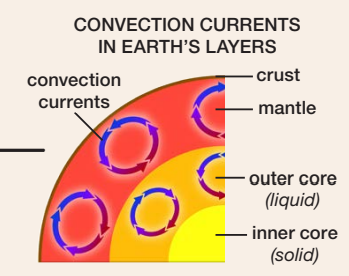
Convection
currents in the outer core produce the Earth's magnetic field.
Inner Core
Geologists use seismic waves to make inferences
about the inner core. The liquid outer
core stops the S waves, but the P
waves enter the inner core and change speed and direction. Their speed and
path indicate that the inner core is a solid ball made mostly of iron.
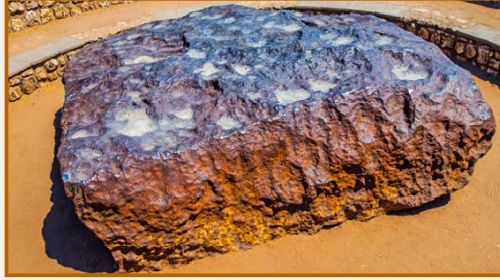
Geologists believe that
the inner core is made of solid material like iron.
In your science
journal,
fill in the blanks.
1.
Geologists believe that the inner core is made up of material similar
to _______.
2.
Convection currents in the outer core produce the Earth's _______
field.
3.
Earth’s mantle is mostly made up of _________.
4.
Earth’s _______ is made up of granite and basalt.